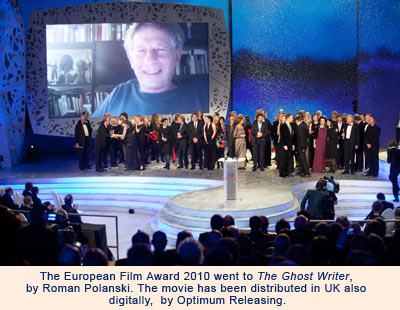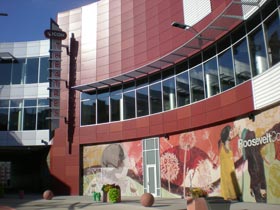WOMEN IN DIGITAL CINEMA
Marta Materska–Samek
Not only support specifically
addressed to cinemas. Calls for proposals aimed at the promotion
of tourism too can help small cinemas willing to shift to digital
technology. To know how read the article written by Marta Materska–Samek.
Cinema Mirko in Krakow, through the “Maloposka” project
supported by the European Social Fund and aimed at enhancing the
tourist attractiveness of the region, has become the leader of a
network that, thanks to digitization, has transformed local cinemas
into tourist attraction. Thus, the “digital art houses”,
showing digital and 3D movies as well as alternative content, have
become part of a combined offer for tourists (weekends with sightseeing
and cinema screening) and of cross-promotion initiatives (promos
on attractions of the towns in the network).
 Marta
is thirty and since she was a teenager she has been connected to cinema.
Being impressed by the mystery of cinema exhibition she worked voluntarily
at the 36th to 44th editions of the Krakow Film Festival devoted to
shorts. During her studies she won an internship at the Apollo Film
Institution, where she was dealing with distribution issues. When she
was on the Socrates Erasmus scholarship - Strasbourg (IEP Robert Schuman
University), she applied for the Eurimages internship and during that
time she deepened her knowledge of film co-production and as a consequence
she gathered material to write a master’s thesis. Marta
is thirty and since she was a teenager she has been connected to cinema.
Being impressed by the mystery of cinema exhibition she worked voluntarily
at the 36th to 44th editions of the Krakow Film Festival devoted to
shorts. During her studies she won an internship at the Apollo Film
Institution, where she was dealing with distribution issues. When she
was on the Socrates Erasmus scholarship - Strasbourg (IEP Robert Schuman
University), she applied for the Eurimages internship and during that
time she deepened her knowledge of film co-production and as a consequence
she gathered material to write a master’s thesis.
After her studies Marta took a job at Apollo
Film – the commercialized former national institution, where she
was responsible for new media and marketing. In those times, there were
very few people in Poland who knew what D-cinema was. One of them was
Tomasz Maciejowski, CEO of Apollo Films. His dilemma was how to save
Kiev cinema (Kijów), which is a place where famous premières
and national film events have taken place. The history of the biggest
cinema, which seats 828, started in 1967, when it was built and opened
to celebrate the fiftieth anniversary of the October Revolution. The
gigantic cinema screen (18m x 10m) showed such events as the world première
of Steven Spielberg’s “Schindler’s List” featuring
the cast and crew of the film. However, the increasing number of multiplexes
constituted a threat to the cinema and hence resulted in the lack of
35mm prints for traditional cinemas to show films on their first run.
The natural solution was to introduce the
D-cinema technology, but the problem was not only financing but also
a lack of critical mass making the investment profitable. In 2005 Marta
was leading a team, whose goal was to prepare a proposal for a call from
SPO WKP 2004-2006 (a sectorial operational funding programme oriented
to strategic investment in SME’s). Despite being positively noted
and approved, unfortunately, the project was put on a reserve list waiting
for allocation, which never came. Finally in 2006, the cinema was equipped
with a 2K Christie d-cinema projector, a Doremi server, a scaler and
a 3D Xpand (former Nuvision) system entering the XDC lease agreement.
(Click
here to read the whole article)
|
The Third Dimension
The most recent data collected by MEDIA Salles
on 3D in Europe, and explained by Elisabetta Brunella in the “Souvenir
Programme” of the 23rd European Film Awards.
 In 2004, only the bat of an eyelid away, there were thirty digital
screens in Europe. Today they have grown to almost seven thousand:
has the digital revolution taken place? Yes and no, considering
that despite the undeniable boom starting in 2009 and continuing
throughout 2010, four fifths of the Continent’s total screens
still rely on 35mm. In 2004, only the bat of an eyelid away, there were thirty digital
screens in Europe. Today they have grown to almost seven thousand:
has the digital revolution taken place? Yes and no, considering
that despite the undeniable boom starting in 2009 and continuing
throughout 2010, four fifths of the Continent’s total screens
still rely on 35mm.
What certainly has come about is the “3D revolution”,
in view of the fact that, out of all the screens that have changed
to the new technology adopting 2K or more recently 4K, almost
80% have also equipped themselves for 3D. Of the over five thousand
3D installations, more than three thousand five hundred are located
on the six leading markets - those that count a yearly average
of at least a hundred million spectators. France, which in 2009
sprang to the lead in the digital transition, is responsible for
the lion’s share with almost 900 units, followed by the
United Kingdom (over 700) and Germany (over 600). Next come Italy
and Russia, both with over 500 installations, and Spain (a little
over 400). Sustained by the availability of products from the
US film industry, which respected the calendar of releases initially
announced, the rush to 3D has been the engine of digitalization
in the past two years. The key to change for this phenomenon was
the hearty welcome given to the new development by audiences,
prepared to pay more for tickets to this type of film and, basically,
finance the purchase of the new equipment. Thus, whilst we shall
still have to wait some time for digitalization in the strict
sense of the term, i.e. for the digital conversion of all the
screens in a complex, and above all to find the necessary resources
to include even the less profitable theatres in the process, 3D
is already immediately available in a large number of venues,
whether multiplexes or not. A passing phenomenon?
There are those who, mindful of the past, in other words the recurrent
but short-lived bouts of interests in 3D, remain fairly sceptical.
Others, instead, in view of the amount of capital invested both
in production and in the theatres, believe that three-dimensional
films, whilst not managing to replace 2D, will become a regular
part of the cinemagoer’s “diet”. Amongst those
who hold this view, for instance, is the Director of the Venice
Festival, Marco Müller, who, when talking about the 3D creative
award instituted by his festival, declared: “3D technology
cannot be labelled a passing whim; fortunately 3D is here to stay.”
And if, up to now, films “made in America” have dominated
the international 3D scenario – with rare European exceptions,
such as the precursor “Fly me to the Moon” –
2010 saw a significant number of titles from the Old Continent
adopting the new technology to try out different languages and
genres. And, most importantly, obtain international distribution.
Thus the range covers a documentary exploring the depths of the
ocean, such as the French-Swiss-Spanish co-production Océans,
to the British Streetdance, an enormous audience success
focusing entirely on dance, to cartoons such as the Finnish Moomins
and the Comet Chase, the Belgian Sammy’s Avonturen
and the recent Winx Club: Magic Adventure from Italy,
not forgetting horror, where the Dutch co-production Amphibious
3D takes its place. Moreover, this passion for 3D is one
of the elements which demonstrates that the digital shift means
far more than simply replacing one type of projector with another.
It is, in fact, true that the movie theatre and what it offers
its audiences are undergoing a transformation. We have witnessed
this with the success of visual music on the big screen –
whether opera or the latest rock concert – with the worldwide
attraction of live sports events in every continent and we can
see it with 3D, which once again makes movie theatres into the
favourite place for enjoying a show that cannot be reproduced
on the small screen at home or on a laptop. What is more, 3D itself
is far more than just the addition of special effects to “normal
films”. In the video interview with Hans Ulrich Obrist for
the latest Biennale of Architecture in Venice, Wim Wenders, commenting
on his 3D film, which takes the audience to discover and, above
all, “listen to” a magical building – the Lausanne
Rolex Centre – said: “3D is a language. In the near
future it will invigorate the documentary, giving it body and
volume.”
And addressing new artists he continued by speaking of the extraordinary
opportunities offered by digital technologies and the Internet:
“Today there are enormous opportunities for creation. My
dream is that in the 21st century communication tools will increasingly
be in the hands of the people rather than in those of the old
powers.” This is the challenge facing theatres and European
cinema, too: that the new technologies should increasingly
transform them into a space for creativity and for the expression
of cultural diversity.
Elisabetta Brunella
Secretary General of MEDIA Salles
This article has been published
in the “Souvenir Programme” of the 23rd European
Film Awards
(Per leggere il testo in
italiano cliccare qui)
The Winners
of the 23rd European Film Awards
|
Digitalization
of Italy’s Cinemas. Mission Impossible?
Up to now around two thirds
of digitalized screens have been installed in multiplexes and
only one third in traditional cinemas. How can smaller cinemas
too have access to the new technologies? At least two steps
seem to be necessary: a joint initiative by exhibitors and
distributors and public support.
Of the four thousand screens in Italy,
located in over two thousand structures, at the end of August just
over five hundred structures were observed to be digitalized for
a total of around seven hundred and fifty screens. To this figure
we should add another eighty or so theatres, also digitalized but
with 1.3 K projectors.
The Italian exhibition system can be divided into two types of
businesses: traditional cinemas with no more than 4-5 screens
spread over the territory in over 1,800 sites located mainly in
the urban centres of Italian towns and cities (around 2,500 screens);
multiplexes with 5-6 screens upwards located in over two hundred
complexes (around
1,500 screens) mostly on the outskirts of the main provincial capitals.
Up to now around two thirds of digitalized screens are installed
in multiplexes and only one third in traditional cinemas.
As regards the rate of digitalization of cinemas, it can be observed
that only twenty-five of them (obviously multiplexes) have more
than three digital screens and no more than ten or so are completely
digitalized.
It is useful to remember that the process of digitalization can
mainly be traced back to the great appeal of three-dimensional screenings
to audiences (it is, in fact, no coincidence that almost all digital
screens are fitted with 3D technology) and that from an economic
and financial point of view the various opportunities offered by
VPF (Virtual Print Fee) and the recent introduction of tax benefits
have made a great contribution.
The situation outlined above reserves little space at the moment
for circulating digital copies that are not in 3D, since existing
cinemas, apart from a very limited number of structures with more
than 3-4 digital screens, mostly find it hard to fill even their
3D film programmes.
Moreover, as regards future prospects for the process of digitalization,
and in particular the possibility of it spreading more widely across
the market, it should be considered that for a large sector of traditional
exhibition the introduction of this technology may not be feasible
for a series of reasons or may at least be delayed until a distant
future. Truth to tell, whilst the multiplexes (especially where
they belong to large or medium-sized circuits), which programme
mostly films by the American majors and a large number of films
in 3D, can easily take advantage of all the tools for facilitating
a digital investment (VPF and tax benefit), there is an insufficient
number of digitally equipped traditional theatres (there should
be at least 300-500 of them), which generally programme quality
or arthouse films and conseqently have no incentive for making the
necessary investments, since they cannot rely on a supply of digital
films and thus cannot benefit from VPF.
Moreover, the tax benefits for these theatres, which have a limited
income and a company structure with few employees, offer insufficient
compensation and are thus of limited use.
The gap between the different types of exhibiting companies becomes
even wider when considering that, in view of the increasing difficulties
of digital projector producers to satisfy the swiftly growing demand,
priority is given to those who have already ordered the equipment
and are able to plan their digital development (the multiplexes).
As can be seen, all this is like a dog chasing its tail –
a situation of stalemate that must be rapidly overcome unless there
is to be a long delay in the digitalization of over half of Italian
cinemas, which are already in delicate economic conditions and will
have to deal with a further competitive disadvantage.
Can something be done to change this scenario?
And what virtuous action can be taken to avoid a situation that
damages a large sector of exhibition, the one in which Italian films
have a greater chance of visibility and of increasing their box-office?
This is what will be discussed in Mantua during the “Incontri
del cinema d’essai” (Arthouse Cinema Meetings). However,
it can certainly be argued that any possibility of reversing the
current trend depends on the one hand on a prompt, strong, joint
attempt by exhibitors and distributors to overcome existing obstacles,
by agreeing on a special “road map”, and, on the other
hand, on the ability of the Ministry of Cultural Affairs and the
Regional Authorities, possibly coordinating their work, in coming
up with appropriate facilitations able to provide a strong incentive
for investment by exhibitors who are in difficulty and lagging behind.
Luigi Grispello
Member of the Agis Presidential Office and Acting Vice-president
of the Anec
(Per leggere il testo
in italiano cliccare qui) |
All different, all digital
by Elisabetta Brunella This
column hosts portraits of cinemas in Europe and the rest of the
world which are quite different from one another but have in common
the fact that they have all adopted digital projection.
Country |
Site |
Town |
Company |
Number
of projectors |
Projector |
Resolution |
Server |
No.
of 3D screens |
Supplier
of 3D technology |
USA |
ShowPlace
Icon at Roosevelt Collection |
Chicago,
IL |
Kerasotes |
16 |
Barco |
2K |
Dolby |
8 |
RealD |
Icon Theatre
  Once
upon a time in the United States, there was Kerasotes, a chain of
cinemas boasting 957 screens. In 2010 the company, founded in Illinois
by a Greek immigrant, was bought up by AMC, number two on the US
cinema market. But after signing a 275-million dollar contract,
the descendants of Gus Kerasotes who, with the opening of a nickelodeon,
placed the foundation stone for what was to become the sixth U.S.
cinema group, did not abandon the family profession. Once
upon a time in the United States, there was Kerasotes, a chain of
cinemas boasting 957 screens. In 2010 the company, founded in Illinois
by a Greek immigrant, was bought up by AMC, number two on the US
cinema market. But after signing a 275-million dollar contract,
the descendants of Gus Kerasotes who, with the opening of a nickelodeon,
placed the foundation stone for what was to become the sixth U.S.
cinema group, did not abandon the family profession.
Today their name is associated with a chain of cinemas, limited
in number but highly innovative. Their Icon Showplace, for example,
has already revolutionized the offer of cinema in the centre of
Chicago, joining in the process by which citizens with economic
resources are encouraged to choose a home in areas traditionally
reserved for offices, businesses or schools. Thus in the new Roosevelt
Place, on the south edge of the Loop, the economic heart of the
city, the Icon’s 16 screens found their place at the end of
2009. With this stylish urban multiplex, the concept of the “Vip
movie theatre” makes its appearance in the United
States, where the cinema is a mainly working-class, family-format
form of entertainment. “Sip, savor, see” - this is Icon’s
promise to their customers. The key elements are the fashionable
design - which attempts to cut all ties with traditional multiplex
kitsch and tends rather to imitate the trendy restaurants of a more
European taste – avant-garde technology and comfort made
for an audience
of adults and, above all, what is innocently termed the “lobby
lounge” but is really a bar selling alcoholic drinks, something
decidedly uncommon in American cinemas.
.jpg) Those who set foot in the Icon thus find a space open to everyone
on the first floor and on the second an area where access is strictly
reserved for those over 21. After passing a brightly painted version
of the old Fiat Cinquecento, and being welcomed by staff who are
as smiling and professional as they are inflexible over age limits,
spectators can take a seat at the bar or at one of the tables overlooking
Chicago’s finest skyscrapers, to order Mediterranean-flavour
delicacies and a vast range of alcoholic drinks, from beers –
at least 15 varieties – to the most sophisticated of cocktails.
But the creations of the barman and the chef, who signs “panini”
and mini-fillets of Angus beef, can also be taken into the theatre.
Here, through a reserved entrance spectators over 21 gain access
to seats they have chosen beforehand in a section specially set
aside for them – a sort of gallery perfectly separated from
the rest of the audience. They will see the film – undoubtedly
one of the latest blockbusters, screened exclusively with digital
technology – from the depths of particularly roomy and comfortable
armchair seats. On special little tables, they will be able to
place their choice of Italian salami and cheeses, a glass of wine
and a decadent dessert. The cost? For a Saturday evening, an estimated
17.50 dollars for the Vip ticket – which rises to 20 dollars if the film is in 3D –
8 for bread, mortadella and Gorgonzola (in Milan reminiscent of
the builder’s packed lunches, in Chicago this is a creation
of the food designers), 6 for a glass of Prosecco, 6 for a slice
of white chocolate cheesecake. But the parking is free and, with
the prices usually found in the Windy City, this is an advantage
that most of the Icon’s customers emphasize with conviction.
Satisfied customers, if out of 227 reviews reported on a site such
as Yelp, 150 assign 4 or 5 stars (the maximum) to the Icon Showplace.
Objections? The vip version of the Icon is rather pricey but those
who are keeping an eye on their spending can always fall back on
the popcorn (bacon flavour is particularly recommended) and enjoy
the previously mentioned free car park and ideal viewing conditions.
In the end, what should count most in a cinema – flawless
sound and vision – are the same, for vips and non-vips alike. Those who set foot in the Icon thus find a space open to everyone
on the first floor and on the second an area where access is strictly
reserved for those over 21. After passing a brightly painted version
of the old Fiat Cinquecento, and being welcomed by staff who are
as smiling and professional as they are inflexible over age limits,
spectators can take a seat at the bar or at one of the tables overlooking
Chicago’s finest skyscrapers, to order Mediterranean-flavour
delicacies and a vast range of alcoholic drinks, from beers –
at least 15 varieties – to the most sophisticated of cocktails.
But the creations of the barman and the chef, who signs “panini”
and mini-fillets of Angus beef, can also be taken into the theatre.
Here, through a reserved entrance spectators over 21 gain access
to seats they have chosen beforehand in a section specially set
aside for them – a sort of gallery perfectly separated from
the rest of the audience. They will see the film – undoubtedly
one of the latest blockbusters, screened exclusively with digital
technology – from the depths of particularly roomy and comfortable
armchair seats. On special little tables, they will be able to
place their choice of Italian salami and cheeses, a glass of wine
and a decadent dessert. The cost? For a Saturday evening, an estimated
17.50 dollars for the Vip ticket – which rises to 20 dollars if the film is in 3D –
8 for bread, mortadella and Gorgonzola (in Milan reminiscent of
the builder’s packed lunches, in Chicago this is a creation
of the food designers), 6 for a glass of Prosecco, 6 for a slice
of white chocolate cheesecake. But the parking is free and, with
the prices usually found in the Windy City, this is an advantage
that most of the Icon’s customers emphasize with conviction.
Satisfied customers, if out of 227 reviews reported on a site such
as Yelp, 150 assign 4 or 5 stars (the maximum) to the Icon Showplace.
Objections? The vip version of the Icon is rather pricey but those
who are keeping an eye on their spending can always fall back on
the popcorn (bacon flavour is particularly recommended) and enjoy
the previously mentioned free car park and ideal viewing conditions.
In the end, what should count most in a cinema – flawless
sound and vision – are the same, for vips and non-vips alike.
(Per leggere
il testo in italiano cliccare qui)
|
| News on the development
of digitalisation in Europe
 WINX 3D: THE ITALIAN DIGITAL FAIRY-HEROINES FLY ROUND THE WORLD WINX 3D: THE ITALIAN DIGITAL FAIRY-HEROINES FLY ROUND THE WORLD
 Italy,
too, has produced its first digital, 3D, animated film: Winx
Club 3D - Magica Avventura. Italy,
too, has produced its first digital, 3D, animated film: Winx
Club 3D - Magica Avventura.
A story of fairy-heroines all ready to defeat the wicked witches,
the pre-screening of Iginio Straffi’s film was presented at
the latest Rome International Film Festival before its release in
Italian movie theatres on 29 October 2010.
Winx Club 3D has also been distributed outside Italy: in
Russia (27 October 2010) and in Turkey (29 October 2010). In 2011
the film should also be out on release in Germany.
(Per
leggere il testo in italiano cliccare qui)
|
3D THE STAR AT THE
PROFESSIONAL DAYS IN SORRENTO
3D was among the protagonists
of the Cinema Professional Days which have just been held in Sorrento,
Italy, from 29 November to 2 December.
As well as the advance screening of Chronicles of Narnia: The
Voyage of the Dawn Treader by Michael Apted, Piranha 3D
by Alexandre Aja, a horror film with Elisabeth Shue and Richard
Dreyfuss, and the animated film Sammy’s Adventures were
also screened in 3D. 25 minutes of pre-screening from the science-fiction
film Tron - Legacy by Joseph Kosinski with Jeff Bridges
were also presented in 3D, as well as the first images from
Sanctum 3D, produced by James Cameron.
The Cinema Professional Days were organized by the ANEC, national
association of cinema exhibitors, in collaboration with the ANEM
exhibitors and the distributors belonging to the ANIC.
The event was attended by around two thousand representatives from
the industry and many actors, directors and authors who came to
present films on release in the coming months or to receive the
Biglietti d’Oro (Golden Tickets) of Italian cinema, the award
given by the ANEC to the films that have had the greatest audience
auccess.
(Per leggere il testo
in italiano cliccare qui) |
ALL DUTCH CINEMAS WILL BE DIGITAL IN 2012
A unique public/private cooperation
makes it possible to change collectively from analogue to digital
technology in the exhibition and distribution branch of Dutch cinema.
The foundation Digitizing Dutch Cinema, founded by the Dutch federation
of film exhibitors and distributors (NVB and NVF) and EYE Filminstitute
Nederland, will implement the digitalisation within two years. Total
costs will be €38,000,000. Secretary of State Zijlstra from
the Ministry of Culture and Science has approved an allowance from
the Dutch Film Fund.
Furthermore, 14% of all the
implementation costs will be covered by the Government from the
National ICT programme (PRIMA). With this amount, allocated especially
for film theatres, digitization of the Dutch exhibition sector will
be carried out. The first digital projectors will be installed in
January 2011. By mid 2012 all film theatres and cinemas will be
able to exhibit digitally and digital distribution will also be
possible.
|
|
MEDIA Salles’ contacts and address
MEDIA Salles
Piazza Luigi di Savoia, 24 - 20124 Milano - Italy
Tel.: +39.02.6739781 - Fax: +39.02.6690410
E-mail: infocinema@mediasalles.it
Sito web: www.mediasalles.it
|
|

![]()
![]()
 I
am happy to announce that for about a month now, MEDIA Salles has also
been present on Facebook. Our aim, which already proved to be appreciated
and shared by over a hundred professional players on the same day it was
announced, is to encourage the exchange of information on European productions,
particularly with regard to digital films and content. The first of the
products created for FB is the section “Italian Cinema: When and
Where”, hosted in the Notes. We invite you to visit it and use in
the spirit of the social network to share information and, by doing so,
allow as many people as possible to find out about your programming, if
you distribute or screen Italian films.
I
am happy to announce that for about a month now, MEDIA Salles has also
been present on Facebook. Our aim, which already proved to be appreciated
and shared by over a hundred professional players on the same day it was
announced, is to encourage the exchange of information on European productions,
particularly with regard to digital films and content. The first of the
products created for FB is the section “Italian Cinema: When and
Where”, hosted in the Notes. We invite you to visit it and use in
the spirit of the social network to share information and, by doing so,
allow as many people as possible to find out about your programming, if
you distribute or screen Italian films.
![]()
 Marta
is thirty and since she was a teenager she has been connected to cinema.
Being impressed by the mystery of cinema exhibition she worked voluntarily
at the 36th to 44th editions of the Krakow Film Festival devoted to
shorts. During her studies she won an internship at the Apollo Film
Institution, where she was dealing with distribution issues. When she
was on the Socrates Erasmus scholarship - Strasbourg (IEP Robert Schuman
University), she applied for the Eurimages internship and during that
time she deepened her knowledge of film co-production and as a consequence
she gathered material to write a master’s thesis.
Marta
is thirty and since she was a teenager she has been connected to cinema.
Being impressed by the mystery of cinema exhibition she worked voluntarily
at the 36th to 44th editions of the Krakow Film Festival devoted to
shorts. During her studies she won an internship at the Apollo Film
Institution, where she was dealing with distribution issues. When she
was on the Socrates Erasmus scholarship - Strasbourg (IEP Robert Schuman
University), she applied for the Eurimages internship and during that
time she deepened her knowledge of film co-production and as a consequence
she gathered material to write a master’s thesis. In 2004, only the bat of an eyelid away, there were thirty digital
screens in Europe. Today they have grown to almost seven thousand:
has the digital revolution taken place? Yes and no, considering
that despite the undeniable boom starting in 2009 and continuing
throughout 2010, four fifths of the Continent’s total screens
still rely on 35mm.
In 2004, only the bat of an eyelid away, there were thirty digital
screens in Europe. Today they have grown to almost seven thousand:
has the digital revolution taken place? Yes and no, considering
that despite the undeniable boom starting in 2009 and continuing
throughout 2010, four fifths of the Continent’s total screens
still rely on 35mm. Once
upon a time in the United States, there was Kerasotes, a chain of
cinemas boasting 957 screens. In 2010 the company, founded in Illinois
by a Greek immigrant, was bought up by AMC, number two on the US
cinema market. But after signing a 275-million dollar contract,
the descendants of Gus Kerasotes who, with the opening of a nickelodeon,
placed the foundation stone for what was to become the sixth U.S.
cinema group, did not abandon the family profession.
Once
upon a time in the United States, there was Kerasotes, a chain of
cinemas boasting 957 screens. In 2010 the company, founded in Illinois
by a Greek immigrant, was bought up by AMC, number two on the US
cinema market. But after signing a 275-million dollar contract,
the descendants of Gus Kerasotes who, with the opening of a nickelodeon,
placed the foundation stone for what was to become the sixth U.S.
cinema group, did not abandon the family profession. WINX 3D: THE ITALIAN DIGITAL FAIRY-HEROINES FLY ROUND THE WORLD
WINX 3D: THE ITALIAN DIGITAL FAIRY-HEROINES FLY ROUND THE WORLD Italy,
too, has produced its first digital, 3D, animated film: Winx
Club 3D - Magica Avventura.
Italy,
too, has produced its first digital, 3D, animated film: Winx
Club 3D - Magica Avventura.